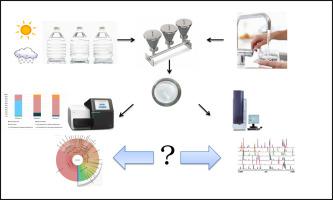International Journal of Food Microbiology ( IF 5.4 ) Pub Date : 2020-08-29 , DOI: 10.1016/j.ijfoodmicro.2020.108850 Laura Sala-Comorera 1 , Laia Caudet-Segarra 2 , Belén Galofré 3 , Francisco Lucena 1 , Anicet R Blanch 1 , Cristina García-Aljaro 1

|
The complex and highly diverse microbial environment of drinking water, consisting mainly of bacteria at different metabolic states, is still underexplored. The aim of this work was to characterize the bacterial communities in tap water and bottled mineral water, the two predominant sources of drinking water in modern societies. A total of 11 tap water samples from a range of locations and distribution networks and 10 brands of bottled natural mineral water were analysed using two approaches: a) heterotrophic plate counts by matrix-assisted laser desorption/ionization time of flight mass-spectrometry (MALDI-TOF MS) for the culturable heterotrophic communities, and b) Illumina amplicon sequencing for total bacteria including non-culturable bacteria. Culturable heterotrophic bacteria were isolated in WPCA (ISO) agar at 22 ± 2 °C for 72 h and 2046 isolates were identified using MALDI-TOF MS. The Bruker Daltonics Library and a previously customized library (Drinking Water Library) were used as reference databases. For the total bacteria fraction, DNA was extracted from 6 L of water and submitted to Illumina 16S rRNA sequencing of the v4 region. Significant differences were observed between mineral and tap water, with a general dominance of Alphaproteobacteria (mainly the genus Blastomonas) in tap water and Gammaproteobacteria in mineral water with Acidovorax being the dominant genus in 3 out of 7 mineral water brands. The bacterial communities in the different brands of mineral water were highly diverse and characteristic of each one. Moreover, the season in which the water was bottled also affected the species distribution, with some of them identified in only one season. Among the culturable bacteria, the most abundant phylum was Proteobacteria (around 85% of the isolates), followed by Actinobacteria, Firmicutes and Bacteroidetes. Proteobacteria was also the most abundant phylum detected with Illumina sequencing (>99% of the reads). The two methods gave distinct results at the different taxonomic levels and could therefore have a complimentary application in the study of microbiota in mineral water environments. MALDI-TOF MS is a promising method for the rapid identification of heterotrophic bacteria in routine water analysis in the bottling industry.
Significance and impact of the study
The complementarity of MALDI-TOF MS and NGS in the assessment of bacterial community diversity has been demonstrated in water intended for human consumption. The two methods are suitable for routine use in the water industry for water quality management.
中文翻译:

揭示自来水和矿泉水微生物区系的组成:下一代测序技术与基于培养的方法之间的差异。
饮用水的主要由处于不同代谢状态的细菌组成的复杂且高度多样化的微生物环境仍未得到充分研究。这项工作的目的是表征自来水和瓶装矿泉水中的细菌群落,这是现代社会中两个主要的饮用水来源。使用两种方法分析了来自各种位置和分配网络的11个自来水样品以及10个品牌的瓶装天然矿泉水:a)通过基质辅助激光解吸/电离飞行时间质谱(MALDI)进行异养菌盘数-TOF MS)用于可培养的异养菌群落,以及b)Illumina扩增子测序,用于包括不可培养细菌在内的全部细菌。将可培养的异养细菌在WPCA(ISO)琼脂中于22±2°C分离72 h,并使用MALDI-TOF MS鉴定出2046个分离株。布鲁克道尔顿图书馆和以前定制的图书馆(饮用水图书馆)被用作参考数据库。对于总细菌级分,从6升水中提取DNA,并进行v4区域的Illumina 16S rRNA测序。在矿泉水和自来水之间观察到显着差异,其中一般以Alphaproteobacteria(主要是属)为主酸性细菌中自来水中的芽孢杆菌和矿泉水中的丙种细菌。是7个矿泉水品牌中3个的主要属。不同品牌的矿泉水中的细菌群落高度不同且各具特色。此外,瓶装水的季节也影响了物种的分布,其中一些仅在一个季节中被发现。在可培养细菌中,最丰富的门是Proteobacteria(约占分离菌的85%),其次是Actinobacteria,Fimicutes和Bacteroidetes。蛋白质细菌也是用Illumina测序检测到的最丰富的门(> 99%的读数)。两种方法在不同的分类学水平上均给出了不同的结果,因此可以在矿泉水环境中的微生物群落研究中具有互补的应用。
研究的意义和影响
MALDI-TOF MS和NGS在评估细菌群落多样性方面的互补性已在拟供人类饮用的水中得到证明。这两种方法适用于水行业中的常规水质管理。


























 京公网安备 11010802027423号
京公网安备 11010802027423号